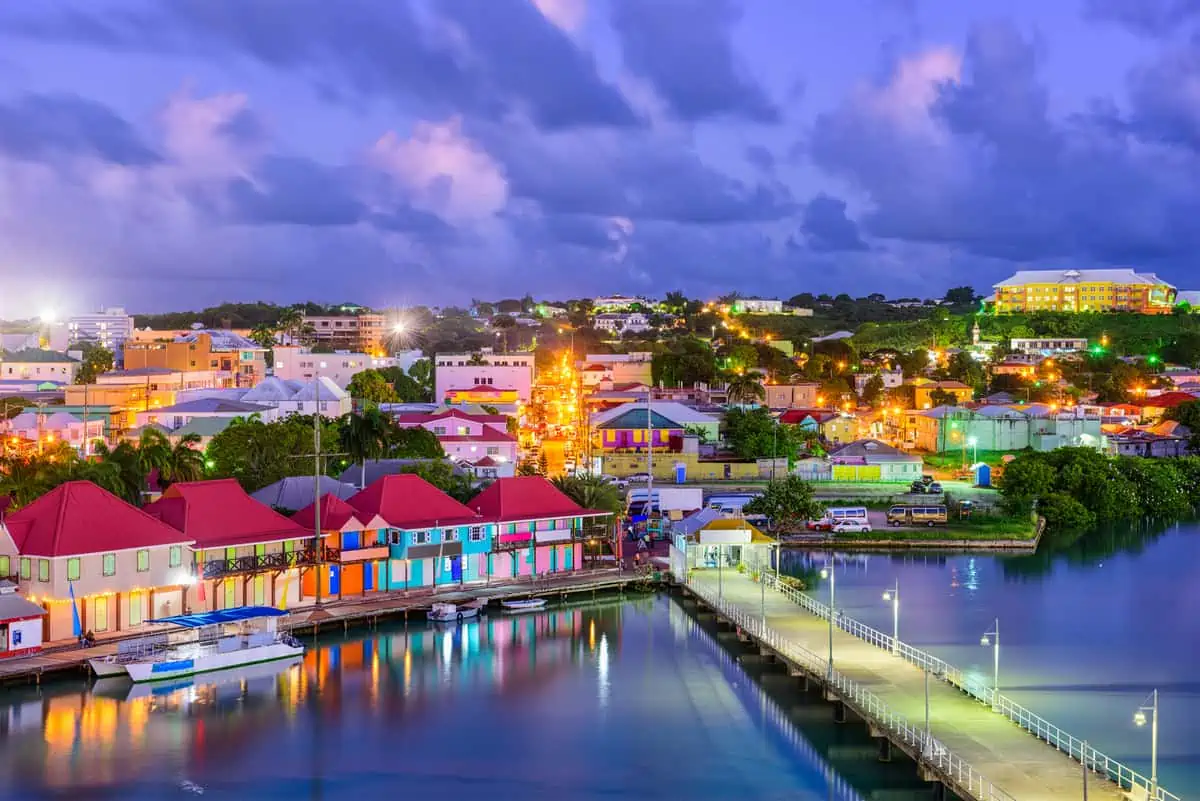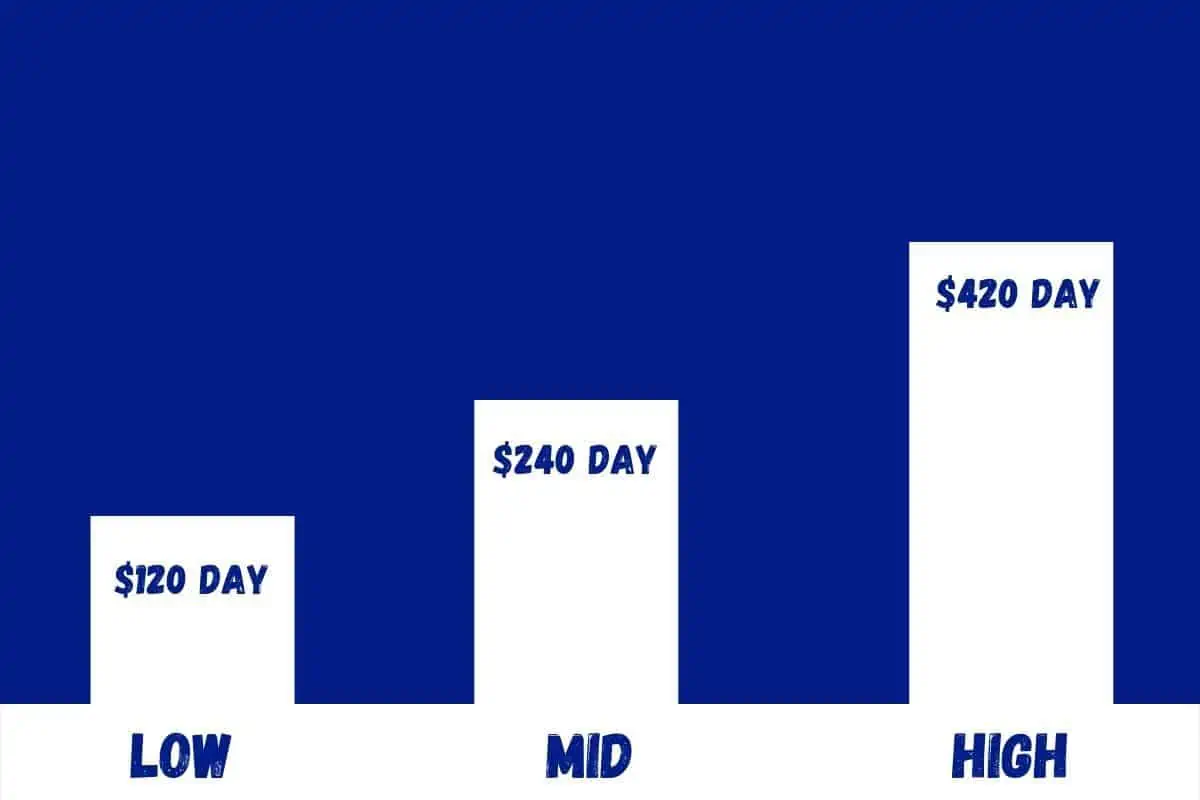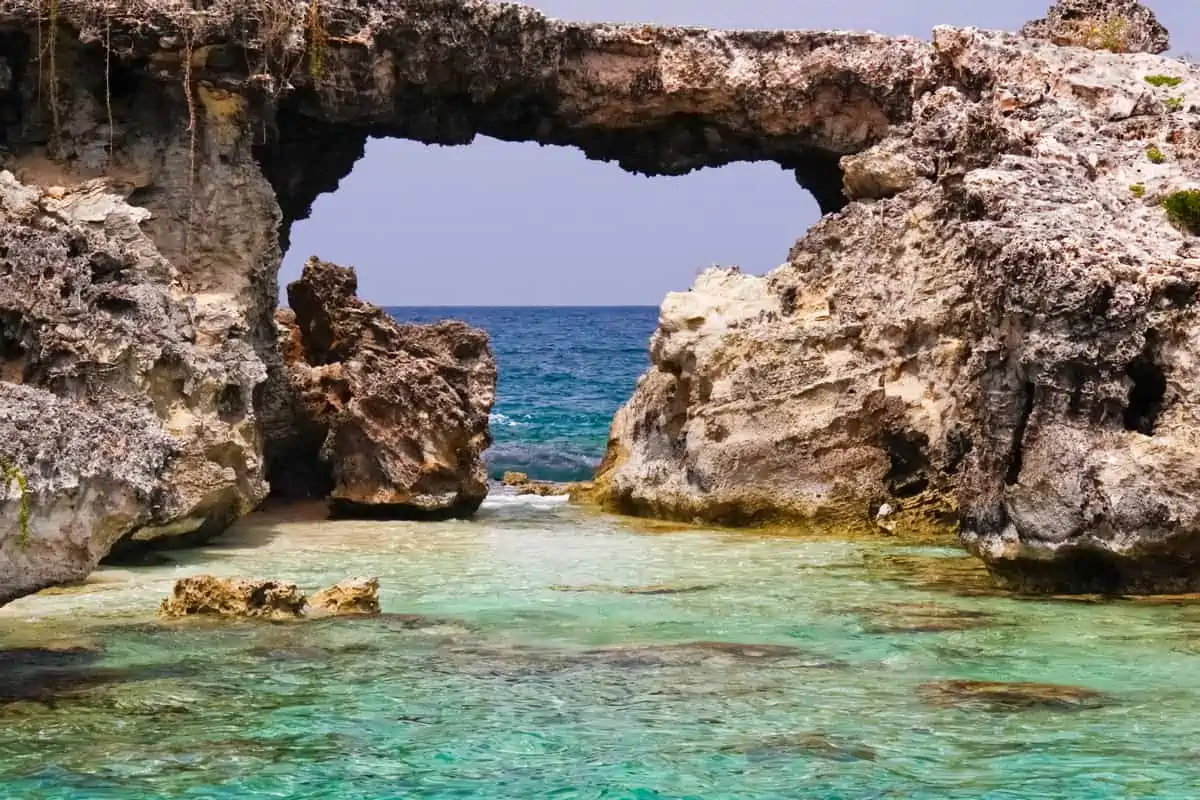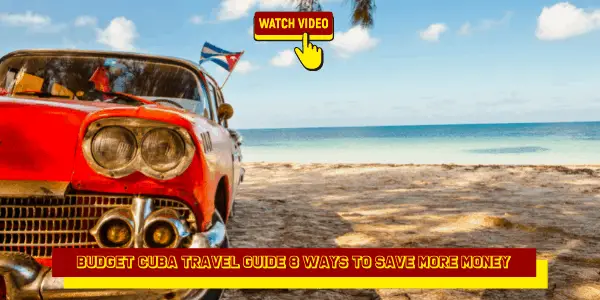Welcome to the Antigua Travel Guide! In terms of exclusivity alone Antigua travel destinations takes some beating. With the island (and its baby brother Barbuda) measuring barely over 108 square miles, real estate is most certainly at a premium! Anyone looking to visit this Caribbean paradise on a more modest budget is going to have to put some serious work into finding good value (read – affordable) accommodation.
Other Posts About the Caribbean |
|---|
| Dominican Republic Travel Guide 8 Ways to Save |
| British Virgin Islands Travel Guide – 8 Ways to Save Money |
| Budget Bahamas Travel Guide 8 Ways to Save More Money |
On the plus side, once you have figured out that little Antigua travel hurdle, costs can be relatively modest providing you are happy to make most of your own fun – and let’s face it, there’s not many easier places on the planet to do that! The Antigua Travel Guide will discuss the must-see attractions, as well as provide plenty of budget-savvy tips to keep those pesky costs as low as possible. If you plan on visiting without a $300/day budget then this should be very handy indeed!
Things To See & Do On Antigua

1. Take A Jaunt Down 17-Mile Beach
Antigua has 365 beaches and this is absolutely one of the best Antigua travel perks, especially for budget visitors. You’ll soon discover that while the public is legally permitted to enjoy free access to every beach, the mega-resorts do their best to make this as awkward as possible in some places. It is a thorny issue and one that annoys locals as much as visiting shoestring-budget.
Antigua travel visitors. 17-Mile Beach is so long that it is impossible to obstruct – and has been kept refreshingly preserved from much development whatsoever. The pink sand is stunningly gorgeous and you’ll have long stretches entirely to yourself regardless of the season. Providing you pack a picnic and a towel to lay down on, you needn’t spend a dime while taking in this frankly ridiculously gorgeous beach.
2. Chill Out At Half Moon Bay
Antigua travel is fantastic for casual hiking and the routes around Half Moon Bay offer some of the most sensational scenery in the world. The Bay is popular with surfers although be warned it can get rough when the wind picks up. Spend your time taking in some wonderful snorkeling (we’ll discuss this budget-friendly diversion a little later), views, and hanging out with other visitors making the most of a perfect beachside experience. It isn’t the easiest place to find or get to and that’s one of the reasons why this sumptuous place has avoided being remotely spoiled by over development.
3. Roam About Nelson’s Dockyard
This 18th century Royal Navy dockyard has recently been named a UNESCO site and nowadays offers some amazingly atmospheric hiking/nature trails, wonderful views, and a dose of colonial-era history too. While you won’t likely see many larger ships passing through nowadays the dockyard and its fortifications are very well preserved. Check out the marina and it’s local stores and cafes if you are feeling flush, or relax with a picnic around the Fort Shirley ruins. You can easily spend a full day making the most of this old dockyard – and it needn’t cost very much whatsoever!
4. Hang-Out In St. John’s
As you may have anticipated, for Antigua travel newbies, the Antiguan capital is a rather tranquil, laid-back, and postcard friendly place to spend a few hours. Explore the extremely smart and yet beguilingly colorful streets at your leisure, marvel at the rather smart boats resting up around the marina, and make sure to check out the local’s markets on Friday and Saturday for some bargains.
A good proportion of the more Antigua travel budget-friendly accommodation is found around St. John’s, so check out the local bars and restaurants a little back from the marina for some better value drinking and dining options. Heritage Quay is handy for stocking up on duty-free drinks, and you should check out the rather magnificent cathedral that includes a smart little free museum too. The national museum of Antigua and Barbuda is also well the modest entry fee (especially if you like naval/pirate themed history).
5. Explore Indian Town National Park
In absolute honesty, it is difficult to tell when national parks really begin and end in for Antigua travel and snorkeling entuastics! The public’s right to roam is one of the best aspects of this gorgeous island and you’re free to head anywhere that isn’t enclosed by a wall or fence (surprisingly large areas). Indian Town National Park provides some breathtaking trails that include the iconic – and somewhat intimidating -Devil’s Bridge. If you like to marvel at nature as well as take in some staggeringly impressive views then the hiking around here is probably the best in the country. There are no entry/access charges so make the most of this bargain attraction for as long as you wish.
6. Windsurfing At Dickenson Bay
Dickenson Bay is popular with more Antigua travel monied visitors (basically everyone else on the island!) although as ever there’s nothing really stopping anyone from dropping by. While sun loungers and parasols are going to set you back $20+ that palm tree serves the same function! While the beach is classically beautiful – and that’s something which will become pretty ‘standard’ during your time here – you’ll find the best windsurfing and diving spots around this particular bay.
Prices can vary between pricy and very expensive, although there’s plenty of places to leisurely snorkel for free and a couple of hours windsurfing can be well worth the $80-100 fees. Pro tip – if you want to eat head back a little from the shoreline. You’ll discover places much cheaper serving up fresher and larger portions.
These are just a handful of the attractions you’ll enjoy in your Antigua travel time. but serve as decent examples of how you’ll likely be spending most of your time. Not many of the budget hotels (or alternatives) offer sumptuous pools or private beaches (thankfully), so expect to spend large parts of your day out exploring. Days on the beach, snorkeling around the waters, or hiking those stunning nature trails don’t need to cost very much whatsoever. Providing you are happy to keep yourself busy for most of the time there’s no end of things to discover during Antigua travel time – and you’ll have an absolute blast doing so.

Typical Costs
Both East Caribbean Dollars (EC$) and US Dollars (US$) are commonly accepted in Antigua. The EC/US prefix is not always applied so make sure that you understand what currency is being used. They are pegged at EC$ 2.7 = US$ 1 and most ATMs only dispense local currency. For the sake of convenience, we’ll estimate all the prices used in the Antigua Travel Guide in US Dollars.
Finding a place to stay within a modest budget is very difficult here unless you are willing to plan months ahead and keep an open mind about alternative options on the market. Choosing one of of our Antigua AirBNB options above is usually a better choice than the pricy resorts.
In general prices are pretty steep but you can have a wonderful time here without spending excessively if you take care when choosing where to shop/eat and how you get around. Here are some essential guidelines that you’ll need to consider right away if you’re intending on taking a budget trip to Antigua.
Hotels
Accommodation is going to be the most significant expense (and hurdle) when planning a budget trip for your Antigua travel. Cheaper hotels do exist even during the peak season, but prices tend to start somewhere around $140-180/night per double room and those in this price bracket book out pretty fast. A good amount of resort-style hotels are used by package tour companies meaning it can be tricky to find a bargain during the busier times of the year.
If you want to stay in a resort you’ll likely be best looking to take either a last-minute deal or visiting at the tail end of the season (late April/May). Assuming you are able/willing to share a double room around $80/night isn’t insane – we are talking about Antigua travel after all – but hardly constitutes what most people would consider a ‘budget’ vacation!
Airbnb & Private Guesthouses
Antigua travel locations don’t have ‘typical’ hostels but you will find a good number of listings on the popular booking sites aimed more towards this end of the market. A high proportion of these are bunkhouses/lodges/B&Bs and prices can vary quite considerable. As a general rule of thumb if you find anywhere offering a bed for less than $70/night you’ve found a good deal!
Campsites are also quite common across the island but they’re almost entirely ‘resort-style’ sites with cabins and chalets that’ll set you back close to what you’d pay in a typical hotel. Great if you are looking for a cabin on the beachfront but bad if you are just after somewhere to sleep for a few hours each night.
Airbnb and Couch surfer do have Antigua travel options and both have some private listings (almost entirely in St John’s) that range from spare bedrooms through to fully furnished apartments capable of sleeping four or more people. Once again prices vary significantly according to the time of year. Expect to pay a minimum of $50/night for a box room (possibly shared) or around $300-400/night for a four-bed apartment.
There is much more room for haggling and negotiating with these kinds of listings so don’t be shy of asking especially if you are looking to stay somewhere for longer than a week. Antigua is so small and easy to get around you don’t really need to stay in more than one place unless you have a specific reason. Antigua travel like everywhere in the world will be cheaper the longer you stay. We sometime get as much as 75% off of the listed price when we stay 30 days or more. Not an option for short term visit but well worth checking out if you are a full time traveler like us.
Food and Drink
Antigua travel visits will find that food is expensive in Antigua. Another reason that we stay AirBNB, we always have a kitchen to cook our own. Self-catering apartments are well worth taking even if they’re pretty expensive upfront because you’ll be able to save a bit of money preparing your own meals. Do be aware that this isn’t quite as handy as it is on some other Caribbean islands as groceries are also steep. If you plan your meals carefully, avoid much in the way of imported items, and use local markets for fresh ingredients you’ll still be doing well to get by on $100/week for food alone.
For Antigua travel, street food – is always the budget travelers best friend – is very pricy along the shoreline and you can expect to pay $20-25 for a portion of grilled fish. Amazing as it’ll taste – again it is hardly what you’d want to spend on a regular basis if you’re traveling on a tight budget! Cafeterias and basic restaurants set back from the popular spots cost about 30% less. Standard restaurant meals are going to cost about the $50 mark before drinks and tips.
Talking of drinks – the local rum is a comparative bargain and Antiguan beer can be found for around $4/bottle. Treble or quadruple that price in the fancier bars and restaurants! Pina Coladas brought to your deckchair can cost as much as $20/drink. Budget visitors are better of sticking to the local dive bars and/or picking up their own supply to drink discreetly on the beach.
Suggested Budget

This all depends on the accommodation you manage to arrange. Let’s be optimistic and assume you find a decent double Airbnb room for $80/night ($40/person). If we’re now looking to keep costs down as far as possible and still manage to have fun you should allow about $30/day for food – mostly preparing your own with perhaps a very light snack while out and about or a couple of drinks. Let’s take a bus to and from a popular beach and expect that to cost about $10 in total.
If we don’t spend anything else whatsoever that’ll amount to around $80/day. From experience, we’d recommend upping that figure to around $100/day because there will be days when you’ll want to do other activities that’ll cost a few dollars here and there. Save up that spare $20 on the days you don’t need it to cover longer bus trips and activity fees.
Overall, it is perfectly possible to enjoy Antigua for $100/day and never need to spend much more than that providing you are willing to skip on organized activities and tours. Tempting as a boat ride can be – it’ll cost around the same as your daily budget, as will surf lessons and diving gear hire. Take the ferry out to Barbuda instead (around $40) if you fancy some sea air and the opportunity to check out this magnificent little island. It’s well worth it!
If you are lucky enough to be able to spend a bit more than our recommended minimum budget then it is up to you how best to do so. There is a substantial gulf between what we’re suggesting and your basic resort-style stay. Expect to spend somewhere in the $250 figure as a minimum if you are looking to enjoy a comfortable hotel, one meal a day in a smarter (but not lavish) restaurant, occasional drinks and perhaps one or two arranged activities and excursions. Those ‘added extras’ can be substantial and will drastically increase your average daily budget.
Money Saving Tips
Finding somewhere affordable to stay in your Antigua travel expedition can be tricky. All-inclusive resorts can be attractive in some ways – at least they include meals and drinks – but are hardly likely to be at the forefront of most independent traveler’s wishlist or budget. It can be worth keeping an eye out for the end of season special offers as prices can drop below $150/day.
Most of these kinds of packages will also include flights that can also be quite heavily discounted. Take a look at these on the off-chance there’s something reasonable and remember that there’s nothing stopping you heading beyond the resort fences.
We’d strongly recommend keeping up a proactive approach when it comes to securing alternative forms of accommodation. There are some Couch surfer hosts but there’s never any guarantee that they’ll follow through with their offer. Airbnb is a more reliable bet and this is pretty varied across the island – just don’t expect to find too many absolute bargains. We’d suggest emailing prospective accommodation in advance and trying to build something like a rapport. Haggling is not common on the island but when it comes to a room for the night anything goes.
Buying or taking along your own snorkel gear is a fantastic way to save money in Antigua. Chances are you’ll only have time to visit at most a dozen of those world-class beaches, but at pretty much all of them there’s somewhere perfect for snorkeling. A good-enough kit should not cost more than about $50 – pretty fair value compared to the standard $20/day for rental.
Picnics should become a daily habit for Antigua travel vistors and budget visitors alike. You will soon get used to taking your own supplies everywhere they go. Beaches may be entirely free to access but literally everything else costs money – including deckchairs and a trip to the bathroom bloc. As discussed earlier groceries aren’t cheap here but will always be cheaper than picking up meals as you go. It is worth considering a few drinks or a bite to eat at some of the beachside restaurants as a good number offer complementary services such as the aforementioned loungers and bathrooms.
Last but not least – take some care where you choose to shop. Everything – from trinkets through to groceries – are much more expensive anywhere close to where cruise line passengers frequent. Save your shopping for the places where the locals go and pick up your souvenirs in local districts instead of tourist areas.
Where To Stay
The Antigua Travel Guide highly recommends starting out by taking a good look at the numerous online resources and taking it from there. Have a browse through package and all-inclusive listings for an idea of how substantially prices can drop around the edges of the peak season. Budget-friendly accommodation is a bit of a specialist market in Antigua and the demand far outstrips supply so don’t expect quite as much variation in prices.
One of the advantages of staying in a more typical hotel is that a good proportion will lay on handy extras such as snorkel gear, airport transfers, and basic concierge services free of charge. We wouldn’t recommend allowing these to influence your decision too much but they are certainly useful bonuses if you end up with no alternative arrangements. Behind the tranquil veneer, the hotel/resort industry is highly competitive and you’ll have some leeway when asking for additional extras to be included in the cost.
Despite Antigua being pretty small not a high proportion of visitors bother to venture too far from their hotels. We’d suggest budget visitors try and do the exact opposite. Fun as St. John’s can be the best beaches are elsewhere and you should get used to taking public buses most days. Almost all the accommodation around popular beaches will charge substantial premiums that are way beyond a $5 bus fare, so be openminded about where you want to stay. Sea views aren’t important – you’ll likely spend hours gazing at them most days anyhow.

How To Get Around
Antigua travel budget visitors will enjoy the fact that Antiguan buses are cheap ($3-5), technically 24 hours, laid back and relatively flexible about drop off points. On the other hand, they don’t tend to depart until they are full – so expect to wait for a little while. Services run between 6 am – 7 pm with occasional late-night services around the busiest parts of the island. Sunday timetables are patchy at best and it is a bad idea to risk waiting for the last scheduled service.
Getting to Barbuda should be a feature for every Antigua travel trip and you’ll need to take either a boat or a very expensive plane ride. Book catamaran tickets in advance as they are very popular during peak season, and expect to pay close to $100 for a return (taking about 90 minutes each way). A good number of more expensive pleasure cruises also stop in Barbuda for a couple of hours but expect to pay $150+ for the day.
A good number of independent visitors like to hire their own vehicle to get around Antigua and it is easy to understand why. A basic vehicle costs as little as $40/day before gas which is barely anything split four or five ways. You could – theoretically – drive around the country a few times within 24 hours, but this is a handy way of getting to remote places outside of the standard bus routes. If you want to find your own tranquil beach then hiring a car is the way to do it.
Bike hire is good for local travel but can become tricky over longer distances because Antiguan roads are quite patchy and bumpy. Plenty of hotels offer these for free (providing you bring them back!) and there are a handful of better-maintained bike suitable trails.
Cabs are everywhere and can be good value providing you negotiate prices at the beginning. Private ‘tours’ cost about $50/hour but longer distances will be charged in terms of mileage, the number of passengers, bags, time of day and so forth. Expect to pay about $15 for a ten-minute daytime ride and $25 after dark. Note that minimum charges apply in some areas especially around the tourist docks no matter how far you intend to travel – so always check first!
When To Plan A Antigua travel Trip
December – April is peak season with dry, balmy, and frankly gorgeous weather. Prices are high, accommodation is scarce, and budget-friendly options will likely be booked up months in advance. Hurricane season starts in July and runs through to November. Some hotels will stay open but a good percentage close for a break or refurbishment. You’ll find some bargains during this time of year but always run that risk of having a long stretch of your stay totally washed out. Parts of Barbuda are still recovering from a serious Hurricane back in 2017.
We would recommend Antigua travel budget visitors look towards visiting around May-June. Temperatures will be a bit hotter but still manageable, yet the crowds will have reduced quite considerably. This is the best time of year for enjoying a good climate with a realistic chance of grabbing that essential accommodation bargain.
How To Stay Safe
Antigua travel is safer than most Caribbean islands and visitors should be perfectly safe providing they follow basic common sense and avoid opportunities to get themselves into trouble. Most serious crime is visitor-on-visitor although there are parts of St John’s that are best avoided after dark (all well away from the tourist areas). Take care around ATMs, know where you are going, avoid offers of drugs, ignore occasional scam artists, and keep your hotel room and balcony locked at all times. Follow those basics, don’t drink too much when out and about, and your visit here should hopefully be totally crime-free.
You shouldn’t encounter any serious environmental risks here but it is wise to take care in the sea as tides and currents can be quite dangerous. If you choose to go snorkeling under your own steam make sure to follow local guidelines and stick to popular/busy spots until you learn the ropes.
In terms of healthcare, Antigua has some good quality medical clinics that are used to patching up visitors. You’ll be thankful for having good medical insurance as prices can become very high indeed. Look for policies that include cover for repatriation costs and ideally some upfront direct payment as well. Pharmacies are well stocked and most major branded medications will usually be available providing you have a suitable prescription from a local doctor. If you lose your script you’ll need to pay for that appointment and the medication upfront.
For complete photos and videos of our trip visit our photos on our page Facebook Page
You May Want to Join Our Boondocking Facebook Group Boondocking Group on Facebook For More Information

